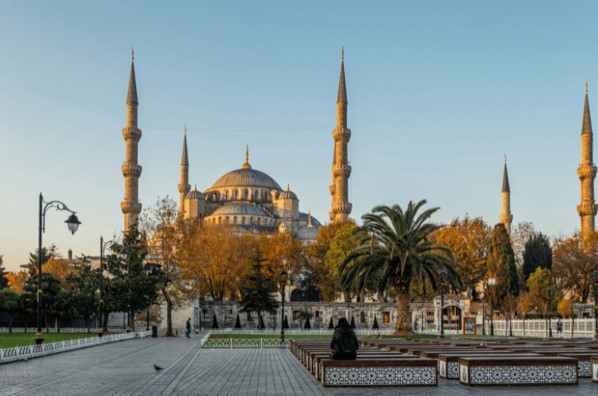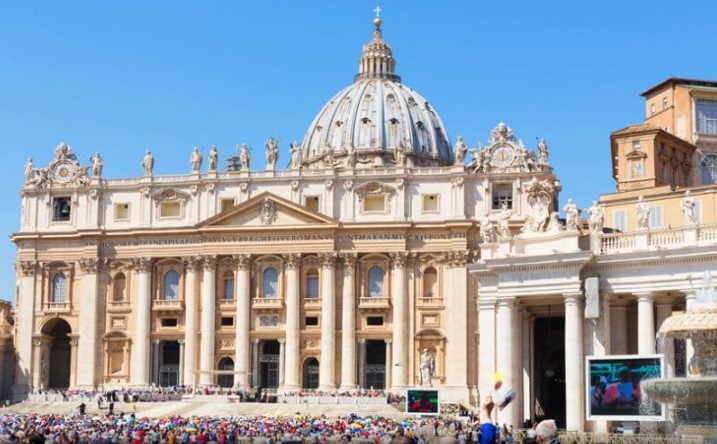Hinaleimoana Wong-Kalu, one of the curators of the new Kapaemahu exhibit at Bishop Museum, poses for a picture in Honolulu on Thursday, June 16, 2022 in entrance of photos of four healers who frequented Hawaii from Tahiti a lot more than 500 many years in the past. The show draws consideration to the stories of the healers, who were “mahu” or men and women who presented by themselves as a combination of male and woman, and highlights gender fluidity’s deep roots in Polynesia. (AP Image/Audrey McAvoy)
AP
HONOLULU
More than 500 yrs ago, Hawaiians put 4 boulders on a Waikiki seashore to honor website visitors from the courtroom of Tahiti’s king who experienced healed the sick. They ended up “mahu,” which in Hawaiian language and society refers to an individual with dual male and woman spirit and a combination of gender features.
The stones were neglected for many yrs, as Christian missionaries and other colonizing Westerners suppressed the role of mahu in Hawaiian culture. At just one point a bowling alley was developed above the boulders.
Officials restored the stones several times considering that the 1960s but informational plaques installed next to them omitted references to mahu.
The stones and the history of the 4 healers now are showcased in an show at Bishop Museum in Honolulu. The exhibit highlights the deep roots of gender fluidity in Polynesia.
Hinaleimoana Wong-Kalu is mahu and a person of the exhibit’s curators. She mentioned the healers had been revered for their talent and hopes their tale will demonstrate children in Hawaii that “proper Hawaiian culture” does not move judgment against people “who have things of duality.”
“They had been highly regarded and honored for the reason that the persons realized that their male and female duality made them even much more powerful a healer,” Wong-Kalu reported.
Kapaemahu was the leader of the 4 healers, and the show is named The Healer Stones of Kapaemahu. Their tale was passed down orally, like all Hawaiian stories, right up until a written language was designed in the 1800s.
But Hawaiians have been discouraged from chatting about mahu. DeSoto Brown, a Bishop Museum historian and the exhibit’s guide curator, stated Christian missionaries who arrived in 1820 forbade everything that deviated from “clearly defined roles and presentation” of male and female genders.
The earliest regarded penned account of the mahu healers is a 1906 manuscript by James Alapuna Harbottle Boyd, the son-in-regulation of Archibald Cleghorn, who owned the Waikiki assets where by the stones had been at the time. Cleghorn’s spouse, Princess Likelike, and daughter, Princess Kaiulani, were being known to area seaweed and provide prayers at the stones when they swam.
Boyd’s manuscript “Tradition of the Wizard Stones of Ka-Pae-Mahu” mentioned the Hawaiian people cherished the healers for their “tall stature, courteous means and kindly manners” and their cures became popular throughout Oahu.
“Their ways and great physique have been overshadowed by their very low, delicate speech, and they grew to become as a single with all those they came in contact with,” Boyd wrote. “They have been unsexed, by nature, and their practices coincided with their womanly seeming, although manly in stature and general bearing.”
When it was time for the healers to leave, 4 boulders were being brought down from Oahu’s Kaimuki area. Two ended up positioned at the web site of the healers’ hut and the other individuals wherever they bathed in the ocean. Idols indicating the twin spirit of the healers had been positioned underneath each individual stone.
Quite a few Hawaiians grew up not knowing about Hawaiian principles of mahu or the stones mainly because the American businessmen who overthrew the Hawaiian monarchy in 1893 banned Hawaiian language instruction in schools and discouraged talking it in properties. Generations of Hawaiians missing connections to cultural traditions.
Wong-Kalu, 50, stated as a baby she was built to believe mahu was a derogatory phrase. She remembers getting among the people who would sit on the stones and drape towels above them just after swimming, oblivious to their importance.
Mahu are akin to “two-spirit” popular in quite a few Indigenous American cultures, Wong-Kalu claimed, adding there are physical, emotional, mental and spiritual components to remaining mahu. The illustration of male and feminine depends on the individual, she explained.
“In Hawaii, one particular could exist seriously in the middle,” she stated.
The stones practically were lost just in advance of the 1941 Japanese attack on Pearl Harbor. At the time, the Honolulu Star-Bulletin claimed the boulders would be blasted or taken out right after a developer leased Cleghorn’s house to build a bowling alley.
Following an outcry, ideas emerged for a concrete walkway between the stones. But the developer rather constructed about them.
The stones were being uncovered two decades later on when the city tore down structures to construct a community seaside park. Elders recalled the tale of the stones and urged they stay. The town agreed and created a plaque that pointed out the Tahitian healers but didn’t say nearly anything about them staying mahu.
In 1997, the city fenced off the stones and devoted a new plaque. It also didn’t reference mahu.
During both durations, waves of homophobia and transphobia washed over Honolulu. In the 1960s, a new state legislation prohibited cross-dressing and police compelled drag performers to use a button indicating: “I Am A Boy.” Three a long time later on, there was backlash in Hawaii and nationally when the Hawaii Supreme Court docket sided with same-sex couples seeking the proper to marry.
The Bishop Museum exhibit, on screen via Oct. 16, recounts this heritage and shows artifacts like massage sticks and a medication pounder that healers would have made use of generations in the past. Islander concepts of gender fluidity are explored via tales like that of King Kamehameha III and his male lover.
A map exhibits conditions made use of in Polynesia for those who really do not recognize as male or feminine, which include “fa’afafine” in Samoa and “leiti” in Tonga.
Dean Hamer and Joe Wilson aided curate the exhibit and hope it will spur the town to inform the complete tale of the mahu at the internet site of the stones.
Ian Scheuring, spokesperson for Honolulu Mayor Rick Blangiardi, claimed the city is exploring the issue and regional leaders system to meet with members of the LGBTQ and Indigenous Hawaiian communities to learn how they can support convey to the “true and complete” story of the healers.
Tatiana Kalaniopua Younger, a Indigenous Hawaiian anthropologist, mahu and a director of the Hawaii LGBT Legacy Foundation, claimed the story the stones and healers helped her spouse and children fully grasp that she was not “this odd creature that is outside the house of the norm.” And that in a Hawaiian feeling, she was section of the norm.
“It gave me a perception of location and function as a mahu and it truly made me proud to be Kanaka Maoli, or Indigenous Hawaiian,” she claimed.
___
This story has been up to date to suitable the title of the exhibit to The Healer Stones of Kapaemahu.





More Stories
Beach Volleyball falls to Long Beach State in Big West Championship
Hawaii’s Hill, Long Beach State’s Valenzuela eager to match wits
Hawaii blocks some Waikiki sands for seal pup